【学海导航】2012届高中英语第2轮复习 专题3 第21课时 事实细节题课件
文档属性
| 名称 | 【学海导航】2012届高中英语第2轮复习 专题3 第21课时 事实细节题课件 | 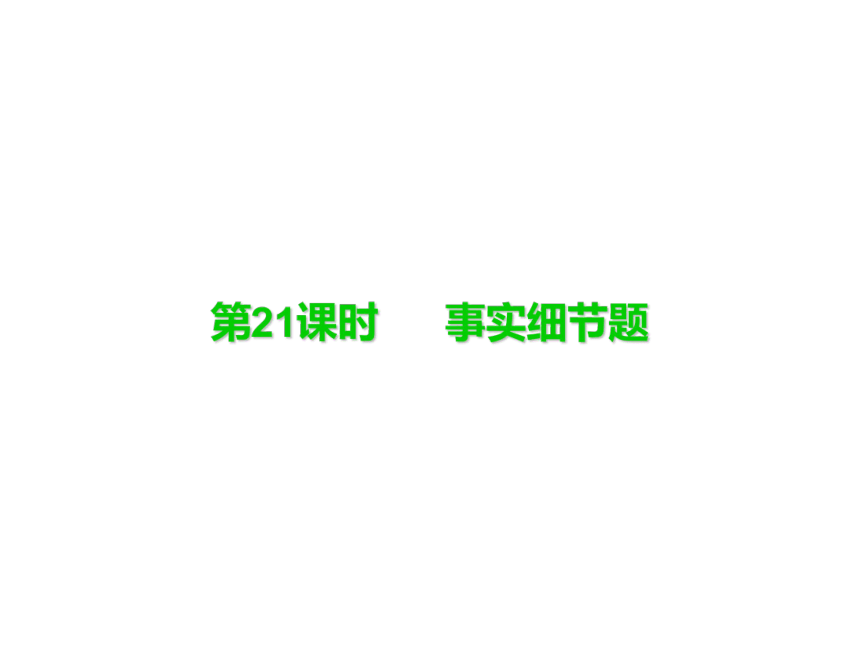 | |
| 格式 | zip | ||
| 文件大小 | 97.1KB | ||
| 资源类型 | 教案 | ||
| 版本资源 | 通用版 | ||
| 科目 | 英语 | ||
| 更新时间 | 2012-02-20 16:52:05 | ||
图片预览

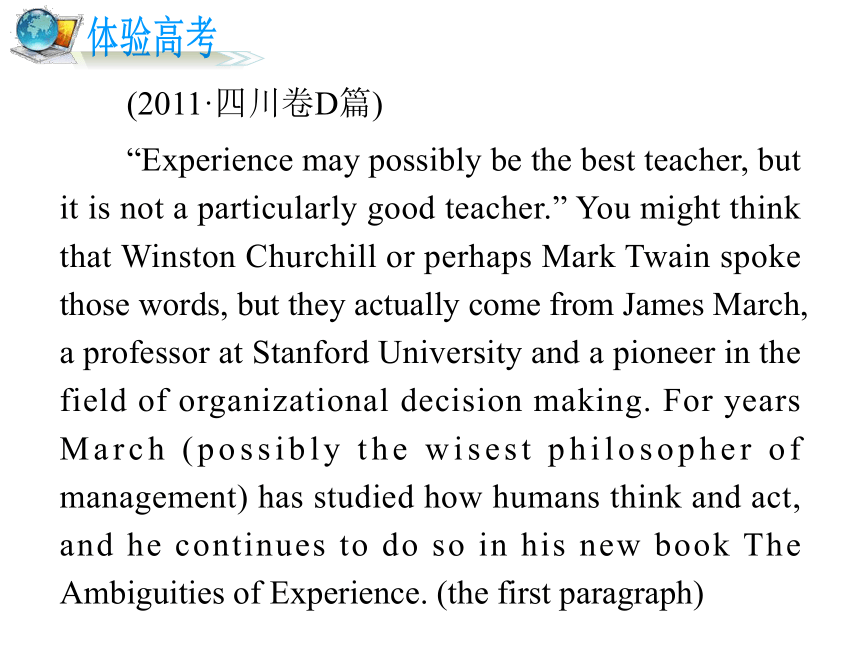
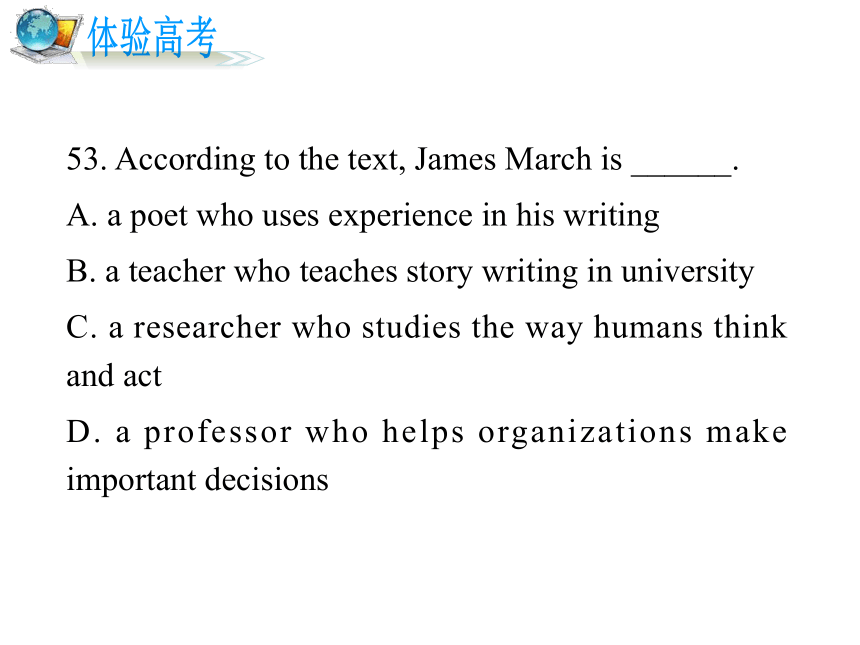
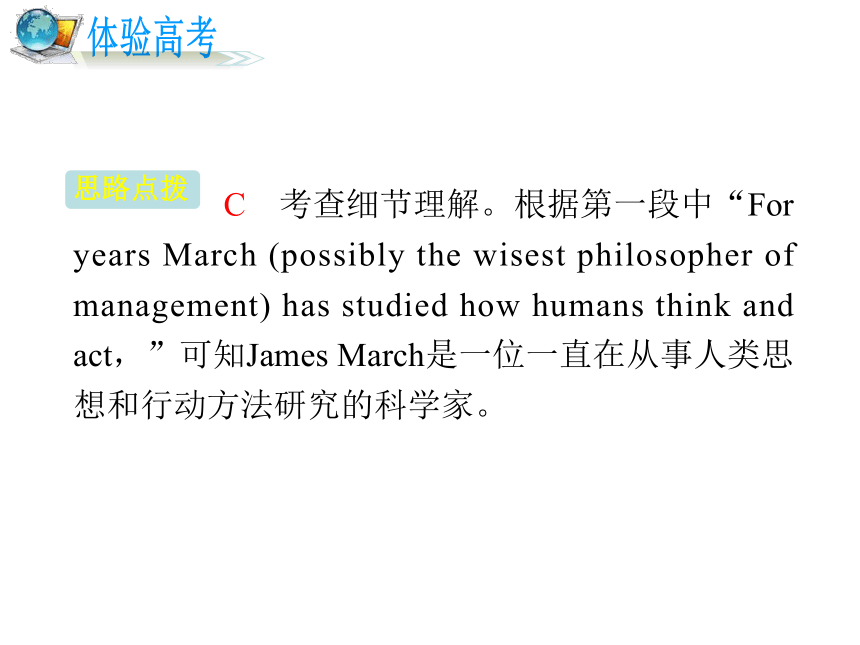

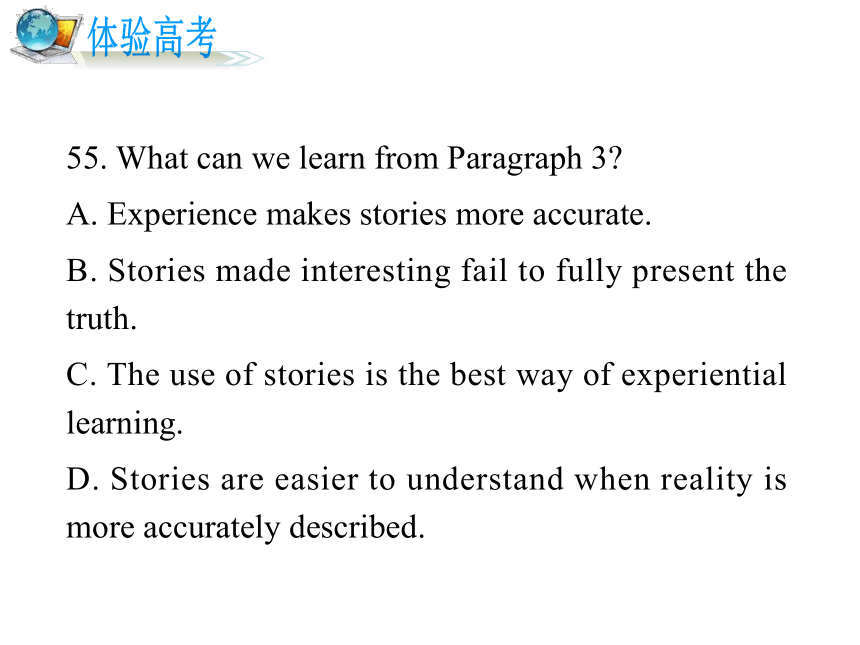
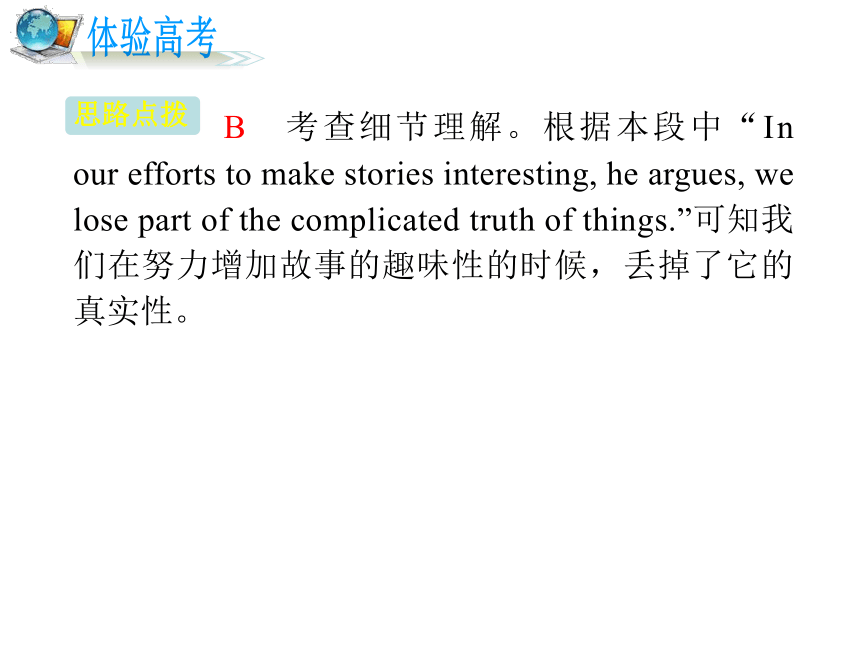
文档简介
(共17张PPT)
第21课时 事实细节题
(2011·四川卷D篇)
“Experience may possibly be the best teacher, but it is not a particularly good teacher.” You might think that Winston Churchill or perhaps Mark Twain spoke those words, but they actually come from James March, a professor at Stanford University and a pioneer in the field of organizational decision making. For years March (possibly the wisest philosopher of management) has studied how humans think and act, and he continues to do so in his new book The Ambiguities of Experience. (the first paragraph)
53. According to the text, James March is ______.
A. a poet who uses experience in his writing
B. a teacher who teaches story writing in university
C. a researcher who studies the way humans think and act
D. a professor who helps organizations make important decisions
C 考查细节理解。根据第一段中“For years March (possibly the wisest philosopher of management) has studied how humans think and act,”可知James March是一位一直在从事人类思想和行动方法研究的科学家。
思路点拨
(2011·四川卷D篇)
In one interesting part of the book,for example,he turns a doubtful eye toward the use of stories as the most effective way of experiential learning. In our efforts to make stories interesting, he argues, we lose part of the complicated truth of things. He says “The more accurately (精确的)reality is presented,the less understandable the story,and the more understandable the story, the less realistic it is.” (the third paragraph)
55. What can we learn from Paragraph 3
A. Experience makes stories more accurate.
B. Stories made interesting fail to fully present the truth.
C. The use of stories is the best way of experiential learning.
D. Stories are easier to understand when reality is more accurately described.
B 考查细节理解。根据本段中“In our efforts to make stories interesting, he argues, we lose part of the complicated truth of things.”可知我们在努力增加故事的趣味性的时候,丢掉了它的真实性。
思路点拨
一篇文章在确定主题之后,通常要通过大量的事实和细节对主题进行解释和说明。因此有很多的题干是根据短文的细节而设计的。文章的细节题有可能是直接理解题,如事物的起因、过程、结果及发生的时间、地点等。也有些是间接理解题,要求你在理解的基础上,通过自己的思维将理解的内容系统化,条理化。选项的表述通常不是用文章的原话,而是使用同义的词语来表达。考生一定要回到短文中找出与答题内容相关的词语和句子,在理解原文的基础上选择答案。
一、所谓细节题的表现形式多种多样,大致可总结如下:
1. 是非题
出题形式:
三正一误(三项正确,只有一项不符合原文内容):
Which of the following is true except…?
Which of the following is mentioned except…?
三误一正(三项错误,只有一项符合原文内容):
Which of the following is true
2. 例证题
例子为高考阅读理解的常见考点之一,这类题的基本结构为The author provides in Line…(或Paragraph…)an example in order to…意思是问文中举出某现象或例子的目的。如果文章是说明文和议论文,文章中举出一些例子无非是为了说明一定的道理。关键在于这个例子在原文出现的位置,但不管如何,这个例子之前或之后不远处通常都有一句总结说明性的话,这句话就是答案,即举例的目的。如果例子与全文主题有关,则例证主题,答案为主题句。如果例子与段落主题有关,就例证段落主题,则答案为段落主题句;否则,答案为例子前后总结说明性的话。
3. 其他形式的细节题
(1)定义
①与主题有关的篇章定义,理解它有助于做主旨题。
②具体对某个现象或术语加以定义,有时成为词义题的考试内容。
(2)年代与数字
这个考点有几种出题方式,但不管以何种形式出现,只要题干问年代与数字,答案就对应于文章中的年代与数字。
(3)比较
比较考点的表现形式主要有:①比较级与含有比较意义的词汇手段和句型结构;②表示绝对意义的字眼:first(第一),least(最不),uttermost(最)等;③表示唯一性的词汇:only,unique等。
阅读最好能圈出表示最高级、唯一性和绝对意义的词汇,便于做题时对回原文定位。
(4)原因
这种题的答案在原文中通常有一些表示因果关系的词汇手段提示:
①表示因果关系的名词:result,reason;
②表示因果关系的动词:result in(结果),result from(由于),base…on…(以……为基础),be due to(由于);
③表示因果关系的连词或介词:because,for,why;
④表示因果关系的副词:as a result,consequently等,阅读时对这些提示词应该予以注意。
除了上述原文有因果关系提示词的显性原因考点之外,隐性原因(两个句子之间为因果关系,但无有关提示词)也是常见考点。不管是显性原因考点,还是隐性原因考点,原文相关句出现的格式都是先说原因,后说结果,而在题干中通常给出结果,就其原因提问。
二、解题方法:
1. 直接理解题
多数细节理解题是直接考查考生对具体信息的近义或反义理解能力。寻找相关的近义或反义表述,是一种有效的解题方式。
代词复指题也属于一种直接理解题。一般是在人物或事物关系比较复杂的情况下使用这种题型,所以理清人物及事物之间的逻辑关系是关键所在。可采用“逻辑关系梳理法”,使人物或事件关系条理化、简明化、明朗化。
转换理解题要求考生在理解具体事实的基础上,通过自己的思维将理解的内容系统化,条理化,形象化,具体化。
一是“首尾定位法”。比如计算、排序、选图等题。排序题要求考生根据事件发生的先后顺序和句子之间的逻辑关系,找出事件发生的正确顺序,即先找出第一个动作和最后一个动作,迅速缩小选择范围,从而快速选出正确答案。
二是利用同义词、近义词和反义词:即命题者常常会利用近义词或反义词来考查学生对细节的捕捉与理解能力。
whereas引导了一个从句,即 a woman's closest female friend might be the first to tell her to leave a failing marriage, 而it wasn't unusual to hear a man say he didn't know his friend's marriage was in serious trouble until he appeared one night asking if he could sleep on the sofa.为主句,其中it为形式主语,真正的主语为不定式 to hear a man…。
第21课时 事实细节题
(2011·四川卷D篇)
“Experience may possibly be the best teacher, but it is not a particularly good teacher.” You might think that Winston Churchill or perhaps Mark Twain spoke those words, but they actually come from James March, a professor at Stanford University and a pioneer in the field of organizational decision making. For years March (possibly the wisest philosopher of management) has studied how humans think and act, and he continues to do so in his new book The Ambiguities of Experience. (the first paragraph)
53. According to the text, James March is ______.
A. a poet who uses experience in his writing
B. a teacher who teaches story writing in university
C. a researcher who studies the way humans think and act
D. a professor who helps organizations make important decisions
C 考查细节理解。根据第一段中“For years March (possibly the wisest philosopher of management) has studied how humans think and act,”可知James March是一位一直在从事人类思想和行动方法研究的科学家。
思路点拨
(2011·四川卷D篇)
In one interesting part of the book,for example,he turns a doubtful eye toward the use of stories as the most effective way of experiential learning. In our efforts to make stories interesting, he argues, we lose part of the complicated truth of things. He says “The more accurately (精确的)reality is presented,the less understandable the story,and the more understandable the story, the less realistic it is.” (the third paragraph)
55. What can we learn from Paragraph 3
A. Experience makes stories more accurate.
B. Stories made interesting fail to fully present the truth.
C. The use of stories is the best way of experiential learning.
D. Stories are easier to understand when reality is more accurately described.
B 考查细节理解。根据本段中“In our efforts to make stories interesting, he argues, we lose part of the complicated truth of things.”可知我们在努力增加故事的趣味性的时候,丢掉了它的真实性。
思路点拨
一篇文章在确定主题之后,通常要通过大量的事实和细节对主题进行解释和说明。因此有很多的题干是根据短文的细节而设计的。文章的细节题有可能是直接理解题,如事物的起因、过程、结果及发生的时间、地点等。也有些是间接理解题,要求你在理解的基础上,通过自己的思维将理解的内容系统化,条理化。选项的表述通常不是用文章的原话,而是使用同义的词语来表达。考生一定要回到短文中找出与答题内容相关的词语和句子,在理解原文的基础上选择答案。
一、所谓细节题的表现形式多种多样,大致可总结如下:
1. 是非题
出题形式:
三正一误(三项正确,只有一项不符合原文内容):
Which of the following is true except…?
Which of the following is mentioned except…?
三误一正(三项错误,只有一项符合原文内容):
Which of the following is true
2. 例证题
例子为高考阅读理解的常见考点之一,这类题的基本结构为The author provides in Line…(或Paragraph…)an example in order to…意思是问文中举出某现象或例子的目的。如果文章是说明文和议论文,文章中举出一些例子无非是为了说明一定的道理。关键在于这个例子在原文出现的位置,但不管如何,这个例子之前或之后不远处通常都有一句总结说明性的话,这句话就是答案,即举例的目的。如果例子与全文主题有关,则例证主题,答案为主题句。如果例子与段落主题有关,就例证段落主题,则答案为段落主题句;否则,答案为例子前后总结说明性的话。
3. 其他形式的细节题
(1)定义
①与主题有关的篇章定义,理解它有助于做主旨题。
②具体对某个现象或术语加以定义,有时成为词义题的考试内容。
(2)年代与数字
这个考点有几种出题方式,但不管以何种形式出现,只要题干问年代与数字,答案就对应于文章中的年代与数字。
(3)比较
比较考点的表现形式主要有:①比较级与含有比较意义的词汇手段和句型结构;②表示绝对意义的字眼:first(第一),least(最不),uttermost(最)等;③表示唯一性的词汇:only,unique等。
阅读最好能圈出表示最高级、唯一性和绝对意义的词汇,便于做题时对回原文定位。
(4)原因
这种题的答案在原文中通常有一些表示因果关系的词汇手段提示:
①表示因果关系的名词:result,reason;
②表示因果关系的动词:result in(结果),result from(由于),base…on…(以……为基础),be due to(由于);
③表示因果关系的连词或介词:because,for,why;
④表示因果关系的副词:as a result,consequently等,阅读时对这些提示词应该予以注意。
除了上述原文有因果关系提示词的显性原因考点之外,隐性原因(两个句子之间为因果关系,但无有关提示词)也是常见考点。不管是显性原因考点,还是隐性原因考点,原文相关句出现的格式都是先说原因,后说结果,而在题干中通常给出结果,就其原因提问。
二、解题方法:
1. 直接理解题
多数细节理解题是直接考查考生对具体信息的近义或反义理解能力。寻找相关的近义或反义表述,是一种有效的解题方式。
代词复指题也属于一种直接理解题。一般是在人物或事物关系比较复杂的情况下使用这种题型,所以理清人物及事物之间的逻辑关系是关键所在。可采用“逻辑关系梳理法”,使人物或事件关系条理化、简明化、明朗化。
转换理解题要求考生在理解具体事实的基础上,通过自己的思维将理解的内容系统化,条理化,形象化,具体化。
一是“首尾定位法”。比如计算、排序、选图等题。排序题要求考生根据事件发生的先后顺序和句子之间的逻辑关系,找出事件发生的正确顺序,即先找出第一个动作和最后一个动作,迅速缩小选择范围,从而快速选出正确答案。
二是利用同义词、近义词和反义词:即命题者常常会利用近义词或反义词来考查学生对细节的捕捉与理解能力。
whereas引导了一个从句,即 a woman's closest female friend might be the first to tell her to leave a failing marriage, 而it wasn't unusual to hear a man say he didn't know his friend's marriage was in serious trouble until he appeared one night asking if he could sleep on the sofa.为主句,其中it为形式主语,真正的主语为不定式 to hear a man…。
